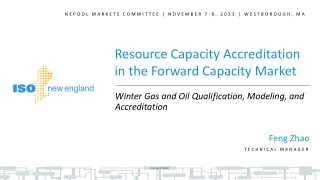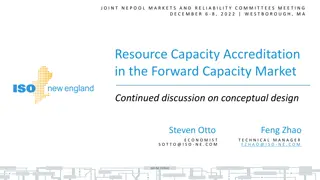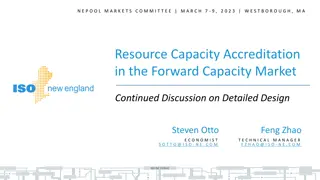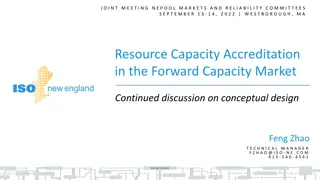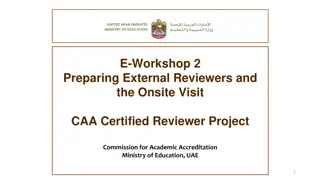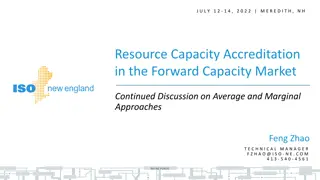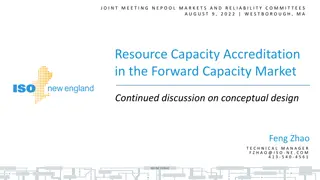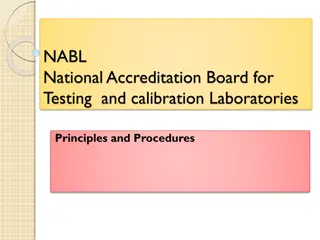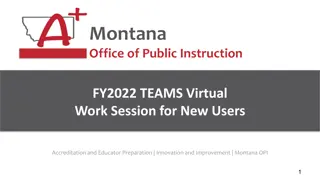Resource Capacity Accreditation in the Forward Capacity Market: Continued Discussion and Detailed Design
The Resource Capacity Accreditation (RCA) project by ISO-NE aims to enhance accreditation processes in the Forward Capacity Market (FCM) to support a reliable, clean-energy transition. This presentation focuses on seasonal components of Capacity Supply Obligations (CSO), Pay-for-Performance (PFP) obligations, and stop-loss provisions. It outlines major design changes, potential PFP designs, and tradeoffs between them. The discussion also includes balancing ratios with seasonal PFP obligations.
- Resource Capacity Accreditation
- Forward Capacity Market
- ISO-NE
- Clean Energy Transition
- Energy Market
Download Presentation

Please find below an Image/Link to download the presentation.
The content on the website is provided AS IS for your information and personal use only. It may not be sold, licensed, or shared on other websites without obtaining consent from the author. Download presentation by click this link. If you encounter any issues during the download, it is possible that the publisher has removed the file from their server.
E N D
Presentation Transcript
N E P O O L M A R K E T S C O M M I T T E E | A P R I L 1 1 - 1 3 , 2 0 2 3 | W E S T B O R O U G H , M A Resource Capacity Accreditation in the Forward Capacity Market Continued Discussion on Detailed Design Steven Otto Feng Zhao E C O N O M I S T T E C H N I C A L M A N A G E R F Z H A O @ I S O - N E . C O M S O T T O @ I S O - N E . C O M ISO-NE PUBLIC
WMPP ID: 157 Resource Capacity Accreditation in the Forward Capacity Market Proposed Effective Date: FCA 19 The Resource Capacity Accreditation (RCA) project proposes improvements to ISO-NE s accreditation processes in the Forward Capacity Market (FCM) to further support a reliable, clean-energy transition by implementing methodologies that will more appropriately accredit resource contributions to resource adequacy as the resource mix transforms The ISO has made a commitment to file proposed improvements to be implemented in time for FCA 19 This presentation will continue discussion on seasonal components of CSO, the corresponding Pay-for-Performance (PFP) obligations, and conforming changes to stop-loss provisions Small numerical examples in this presentation are for illustration purposes only and do not reflect or imply actual market impact of RCA ISO-NE PUBLIC 2
WMPP ID: 157 Resource Capacity Accreditation in the Forward Capacity Market Proposed Effective Date: FCA 19 Outline of today s discussion: Review of Seasonal Quantities and Major Design Changes under RCA(slides 5-9) Seasonal PFP Obligations (slides 11-12) Review of Existing PFP Concepts (slides 14-15) Review of Potential PFP Designs (slides 17-19) Overview of Tradeoffs Between Potential PFP Designs (slides 21-23) Conforming Changes with Seasonal PFP Design (slides 25-28) Balancing Ratio with Seasonal PFP Obligations (slide 30) Appendices Appendix A: Major Design Changes and Resource Obligations under RCA Appendix B: Demonstrating Concern 1 Appendix C: Demonstrating Concern 2 Appendix D: Conforming Changes to Monthly Stop-Loss Limit Appendix E: Balancing Ratio with Seasonal PFP Obligations ISO-NE PUBLIC 3
REVIEW OF SEASONAL QUANTITIES AND MAJOR DESIGN CHANGES ISO-NE PUBLIC ISO-NE PUBLIC 4
Introduced March MC Seasonal Components of QMRIC Resource s QMRIC represents its annual reliability contribution (normalized by MRIperfect), as the sum of its seasonal components or contributions, i.e., ????? = ???????????+ ??????????? The above seasonal (summer or winter) components of QMRIC are: ???????????= ???????? ?????????/?????????? ???????????= ???????? ?????????/?????????? ISO-NE PUBLIC 5
Introduced March MC Seasonal Components of CSO CSO is the clearedportion (CSO/QMRIC) of QMRIC Similar to QMRIC, a resource s annual CSO can also be represented by the sum of its summer and winter components: ??? = ?????????+ ????????? The summer or winter component of CSO represents the same cleared portion of the corresponding seasonal QMRIC component: ?????????= ??????????? ???/????? ?????????= ??????????? ???/????? ISO-NE PUBLIC 6
Introduced March MC Seasonal ECSOs With seasonal components of CSO, seasonal ECSOs can be directly linked to those seasonal components rather than the annual CSO: ?????????? = ???????? ???????????????????? ?????????? = ???????? ???????????????????? The above seasonal ECSO represents the same portion of corresponding seasonal QC as the cleared portion ISO-NE PUBLIC 7
Summary on Seasonality Under RCA, the new capacity product is still an annual product Resource Adequacy Assessment (RAA) base case, which is used to derive resource MRIs and capacity demand curves, is constructed at the annual LOLE criterion of 0.1 days/year Seasonal QMRIC components are annualized accreditation values (i.e., normalized by the annual perfect capacity MRI) The annual design includes seasonal ingredients Seasonal parameters (e.g., seasonal QCs) are modeled in RAA for more accurate accreditation Seasonal QMRIC and CSO components allow for monthly trades based on resources seasonal capabilities or obligations ISO-NE PUBLIC 8
Major Design Changes under RCA RCA brings a new MRI-based capacity product into capacity market design, which entails a wide range of design and conforming changes Appendix A summarizes a list of major design changes under RCA The proposed MRI-based design and conforming changes improve the existing FCM design by better aligning capacity market with resource adequacy ISO-NE PUBLIC 9
SEASONAL PFP OBLIGATIONS ISO-NE PUBLIC ISO-NE PUBLIC 10
ISO has been Considering Annual and Seasonal Approaches to PFP The March MC materials noted that the ISO is considering two potential designs for PFP under the RCA reforms: annual PFP obligations and seasonal PFP obligations Annual PFP obligations would obligate resources to cover a constant share of the system s needs throughout the year E.g., a resource that is obligated to cover 1% of the system s needs in the summer would be obligated to cover 1% of the system s needs in the winter, regardless of their expected performance across the two seasons Seasonal PFP obligations would obligate resources to cover different shares of the system s needs in the summer and winter, reflecting their expected performance in those seasons E.g., resources that best perform in the summer would be obligated to cover a larger share of the systems needs in the summer than the winter ISO-NE PUBLIC 11
ISO Proposes Seasonal PFP Obligations The following slides describe the tradeoffs between the two designs: An annual design may create a misalignment between a resource s expected seasonal performance and its PFP obligation in that season, which may increase their risk Under a seasonal design, resources that are compensated similarly in the FCM may have different PFP obligations associated with their forward positions Addressing both considerations is not possible under a market that trades a single annual product The ISO s current thinking is to prioritize addressing the misalignment issue, and so is planning to pursue seasonal PFP obligations ISO-NE PUBLIC 12
REVIEW EXISTING PFP CONCEPTS ISO-NE PUBLIC ISO-NE PUBLIC 13
PFP Performance Payment Calculation will Largely Remain the Same under the RCA Reforms Introduced March MC Each resource that has a CSO and/or produces energy receives a payment (or charge) depending on their CSO and output during CSCs E.g., if a resource has 1% of the total CSO during a CSC, it is expected to provide 1% of the system s energy and ancillary service needs. Any deviations (positive or negative) are settled at the Performance Payment Rate (PPR) The performance payment is calculated for each interval where there is scarcity on the system as: ???? ???? ??? ????????= ??? ?? ? ??? Resource ? s Share of System Needs Performance Payment Rate System Needs: Energy and A/S Requirement ISO-NE PUBLIC 14
Introduced March MC Expected PFP Obligation Expected PFP Obligation: the expected MW quantity that a resource needs to provide in a given period to avoid PFP charges ???? ???? ???????? ??? ????????????= ?[???] ???? ????represents a resource s share of obligation The CSO defining the share ???? ???? can be annual or seasonal values, depending on the design choice This term will be useful when comparing the annual and seasonal designs ISO-NE PUBLIC 15
REVIEW OF POTENTIAL PFP DESIGNS ISO-NE PUBLIC ISO-NE PUBLIC 16
Review Annual PFP Obligation Design Under an annual PFP obligations design, resources expected PFP obligations would be set by their share of annual CSO throughout ???? ???? Resources would have an obligation to cover (via performance or paying the PPR) a constant share of the system s needs (E&AS) throughout the year E.g., a summer-only resource that has an obligation to cover 1% of the system s summer needs would also have an obligation to cover 1% of the system s winter needs, even though it has no physical capability to deliver on that responsibility in the winter the year ISO-NE PUBLIC 17
Review Seasonal PFP Obligation Design Under a seasonal PFP obligations design, resources expected PFP obligations would be set by their share of seasonal CSO component (i.e., CSO component relative to the sum of that season s CSO components) Resource s summer share would be given by ????,?????? ????,??????, while their ????,?????? ????,?????? winter share would be given by As a result, resources would have an obligation to cover different shares of the system s needs, depending on their expected performance in each season E.g., a summer-only resource that has no contribution to system reliability in the winter will have no PFP obligation during the winter ISO-NE PUBLIC 18
Summary of Annual and Seasonal PFP Designs An annual PFP obligation design would result in identical expected PFP obligations throughout the year for resources with the same amount of CSO E.g., a solar resource with 1 MW of CSO and an off-shore wind resource with 1 MW of CSO would have the same expected PFP obligation in the summer and the same expected PFP obligation in the winter, despite the fact that their expected performance across the two seasons differs substantially A seasonal PFP obligation design would result in different expected PFP obligations throughout the year for resources with the same CSO E.g., the same solar and wind resources would likely have different expected PFP obligations in both the summer and winter, reflecting their differing abilities to perform during those two seasons ISO-NE PUBLIC 19
TRADEOFFS BETWEEN THE TWO DESIGNS ISO-NE PUBLIC ISO-NE PUBLIC 20
ISO Must Consider Two Competing Concerns When Deciding on an Annual vs. Seasonal PFP Design Concern 1: The misalignment between a resource s seasonal performance and its PFP obligation may increase their PFP risk Concern 1 was discussed in the March MC materials. Appendix B includes a numerical example that demonstrates Concern 1 Concern 2: Awarding seasonal PFP obligation may lead to cases where resources that are paid equivalently for the same annual CSO in the FCM may need to deliver different quantities of energy and ancillary services during the delivery period to avoid PFP charges It is not possible to jointly address both concerns in an annual forward market that trades a single annual product A seasonal PFP obligation design addresses Concern 1 but results in Concern 2, while an annual PFP obligation design addresses Concern 2 but faces Concern 1 ISO-NE PUBLIC 21
Concern 2 May Occur when the Distribution of RAA MRI Hours does not Match the Distribution of CSCs Appendix C demonstrates Concern 2 using a numerical example with the same resources and parameters from the March MC materials, except that the distribution of CSCs is skewed towards the winter rather than the summer Concern 2 does not occur in the example from the March MC/RC materials, where the distribution of RAA MRI Hours is explicitly assumed to match the distribution of CSCs Key results in this example: Both resources are estimated to reduce unserved energy equally Both resources will have expected PFP payments = $0 in both seasons because their performance during the CSCs is consistent with the performance implied by their seasonal MRI, and both resources therefore have equal expected capacity revenue Because the CSCs are primarily expected to occur in the winter in this example, the winter resource s forward position obligates it to deliver more energy and ancillary services (in aggregate) during the CSCs than the summer resource Thus, the winter resource s expected PFP costs (including opportunity costs from taking on a CSO and not earning PFP payments in the delivery period) are higher than the summer resource s expected PFP costs Note if the distribution of CSCs was skewed more towards the summer relative to the RAA MRI Hours, the summer resource would have higher expected PFP costs than the winter resource ISO-NE PUBLIC 22
ISOs Current Thinking is to Pursue Seasonal PFP Obligations to Address Concern 1 Both concerns cannot be addressed by a market that trades a single annual product While the ISO is exploring the potential for alternative FCM commitment horizons, this is not feasible for FCA 19 Presently, the ISO believes it is most important to address Concern 1 and thereby avoid awarding performance obligations to resources that the ISO does not expect the resources can meet As a result, the ISO s current thinking is to implement seasonal PFP obligations based on seasonal components of CSO ISO-NE PUBLIC 23
CONFORMING CHANGES FOR SEASONAL PFP OBLIGATIONS ISO-NE PUBLIC ISO-NE PUBLIC 24
Conforming Changes to the Monthly Stop-Loss Limit are Necessary with Seasonal PFP Obligations The monthly stop-loss limit is the maximum PFP charge a resource can incur in a given month Under current rules, the monthly stop-loss limit for a given resource ? is: ???? ?? ???? ???? ????? = ??? ???????? ????? ???? With seasonal PFP obligations, seasonal CSO components would be used in place of ???? to determine PFP payments Because CSO components would be smaller than ????, setting monthly stop-loss using FCA starting price times the CSO components would cause monthly stop-loss to bind more quickly Conforming changes to the monthly stop-loss limit are thus necessary ISO-NE PUBLIC 25
Under Seasonal PFP, the Monthly Stop-Loss Limit would be set by Resources Estimated Expected Performance Current thinking is to set resources monthly stop-loss limit by their estimated expected performance during that season s RAA MRI hours We call this value their Seasonally Adjusted CSO This conforming change would essentially scale up the seasonal CSO components so that the monthly stop-loss would be closer to the current monthly stop-loss values Appendix D demonstrates how the Seasonally Adjusted CSO would be calculated mathematically ISO-NE PUBLIC 26
Annual Stop-Loss Limit and Seasonal PFP The annual stop-loss limit is currently given by: ?????? ???? ???? ????? = ??? ???? [3 ??? ???????? ????? ??? ???????? ????? (12 ??? ???????? ?????)] Under seasonal PFP obligations, the annual stop loss limit will still be set by their maximum annual CSO that they take on in a given month ISO-NE PUBLIC 27
If the RAA Process Models all Risk in a Single Season, PFP Obligations would be Set Annually With seasonal PFP obligations, an administrative rule is required to determine how PFP obligations would be set in a season where the RAA process models no risk of EUE E.g., if the RAA process models all risk as occurring in the winter, resources annual CSO would equal their winter CSO component and so no resources would have summer CSO components Under such circumstances, resources would be obligated throughout the year based on their annual CSO Similarly, the monthly stop-loss limit would also be set by annual CSO in this case ISO-NE PUBLIC 28
BALANCING RATIO UNDER SEASONAL PFP OBLIGATIONS ISO-NE PUBLIC ISO-NE PUBLIC 29
Under Seasonal PFP, a BR that Exceeds 1 will not Imply a Resource is Obligated above their Physical Capability The March MC materials noted that a seasonal PFP obligation design would likely result in higher balancing ratios These higher balancing ratios would not imply that resources would be more likely to obligated above their expected physical capability In follow-up to a request from the March MC, Appendix E includes a numerical example that demonstrates that a resource obligated to provide a given share of the system s needs will have identical PFP payments under the current rules (with a BR < 1) and under seasonal PFP obligations (with BR = 5) Numerical example assumes a balancing ratio = 0.67 under current rules, consistent with the average balancing ratio during the December 24th capacity scarcity condition ISO-NE PUBLIC 30
CONCLUSION ISO-NE PUBLIC ISO-NE PUBLIC 31
Key Takeaways The ISO is weighing two concerns when considering PFP under the RCA reforms: Concern 1: The misalignment between a resource s seasonal performance and its PFP obligation may increase their PFP risk Concern 2: A seasonal PFP obligation design may lead to cases where resources that are paid equivalently in the FCM must deliver different quantities of energy and ancillary services during the delivery period to avoid PFP charges Both concerns cannot be addressed in a market that trades a single annual product ISO s current thinking is to implement seasonal PFP obligations to address Concern 1 Conforming changes are needed to both the monthly and annual stop-loss limits under a seasonal PFP construct ISO-NE PUBLIC 32
STAKEHOLDER SCHEDULE ISO-NE PUBLIC ISO-NE PUBLIC 33
RCA Stakeholder Process There are several broad phases laid out for this proposal in the stakeholder process: Background, Conceptual Design, & Education: June 2022 January 2023 Detailed Design: November 2022 April 2023 Finalize Design, Review Tariff Language, and Stakeholder Amendments: May 2023 August 2023 Voting: September 2023 (Technical Committees) and October 2023 (Participants Committee) There are also several key dates for the impact assessment projected in the process: September 2022: Introduce proposed impact assessment approach February 2023: Review updated IA scenarios April 2023: Review initial results July 2023: Final report 2022 2023 2024 Q1 F Q2 J Q3 A Conceptual Design Q4 N Q1 F Q2 Q3 Q4 J S O D J M A M J Final Design, Review Tariff, and Amendments J A S O N D J M Current Schedule MC/RC Vote PC Vote Eff. Date File Detail Design Introduce IA Approach Review Updated IA Scenarios Review Initial IA Results Final IA Report FERC Order ISO-NE PUBLIC 34
Stakeholder Schedule Conceptual Design Phase JUNE 2022 T W 1 7 8 14 15 21 22 28 29 S M T 2 9 16 23 30 F 3 S 4 Joint Markets and Reliability Committees MC Meeting Dates: June 7-8, 2022 (with joint RC during RCA components)(link to materials) Posting Materials Beginning: June 1, 2022 Topics: Review background and discuss opportunities for adjusting the way resources are accredited in the FCM to support a reliable, clean-energy transition 5 6 10 17 24 11 18 25 12 19 26 13 20 27 JULY 2022 T W S M T F 1 8 S 2 9 Joint Markets and Reliability Committees MC Meeting Dates: July 12-14, 2022 (with joint RC during RCA components) (link to materials) Posting Materials Beginning: July 6, 2022 Topics: Discussion of ISO's design objectives and conceptual design. Stakeholders should submit additional clarifying questions on average and marginal approaches to the MC Secretary by June 24, 2022 3 4 5 6 7 10 17 24 31 11 18 25 12 19 26 13 20 27 14 21 28 15 22 29 16 23 30 AUGUST 2022 T W 2 3 9 10 16 17 23 24 30 31 S M 1 8 15 22 29 T 4 11 18 25 F 5 S 6 Joint Markets and Reliability Committees MC Meeting Dates: August 9-10, 2022 (with joint RC during RCA components) (link to materials) Posting Materials Beginning: August 3, 2022 Topics: Continue discussion of ISO's conceptual design. Stakeholders should submit additional clarifying questions on average and marginal approaches or the conceptual design to the MC Secretary by July 22, 2022 7 12 19 26 13 20 27 14 21 28 SEPTEMBER 2022 M T S W T 1 8 F 2 9 S 3 Joint Markets and Reliability Committees MC Meeting Dates: September 13-14, 2022 (with joint RC during RCA components) (link to materials) Posting Materials Beginning: September 7, 2022 Topics: Continue discussion of conceptual design and review proposed impact assessment approach. Stakeholders should submit remaining clarifying questions on average and marginal approaches or additional questions on the conceptual design to the MC Secretary by August 22, 2022 4 5 6 7 10 11 18 25 12 19 26 13 20 27 14 21 28 15 22 29 16 23 30 17 24 ISO-NE PUBLIC 35
Stakeholder Schedule Conceptual/Detailed Design Phase OCTOBER 2022 T W Joint Markets and Reliability Committees MC Meeting Dates: October 12-13, 2022 (with joint RC during RCA components) (link to materials) Posting Materials Beginning: October 5, 2022 Topics: Continue discussion of conceptual design. Stakeholders should submit remaining clarifying questions on average and marginal approaches, additional questions on the conceptual design, and any feedback on the Impact Assessment to the MC Secretary by September 26, 2022 Additional Joint Markets and Reliability Committees RC Meeting Date: October 18, 2022 (with joint MC during RCA components) (link to materials) Posting Materials Beginning: October 12, 2022 Topics: Continue discussion on ISO's conceptual design and review proposed impact assessment scope and scenarios S M T F S 1 8 2 9 3 4 5 6 7 10 17 24 31 11 18 25 12 19 26 13 20 27 14 21 28 15 22 29 16 23 30 NOVEMBER 2022 M T 1 7 8 14 15 21 22 28 29 S W 2 9 16 23 30 T 3 10 17 24 F 4 S 5 Joint Markets and Reliability Committees MC Meeting Dates: November 8-10, 2022 (with joint RC during RCA components) (link to materials) Posting Materials Beginning: November 2, 2022 Topic: Review design elements associated with MRI framework revisions 6 11 18 25 12 19 26 13 20 27 DECEMBER 2022 T W Joint Markets and Reliability Committees MC Meeting Dates: December 6-8, 2022 (with joint RC during RCA components; TC invited to participate in RCA discussions) (link to materials) Posting Materials Beginning: November 30, 2022 Topic: Review detailed design elements associated with MRI framework revisions. Introduce framework for integrating gas limitations into resource adequacy S M T 1 8 15 22 29 F 2 9 S 3 4 5 6 7 10 17 24 31 11 18 25 12 19 26 13 20 27 14 21 28 16 23 30 Reliability Committee RC Meeting Date: December 14, 2022 (MC invited to participate in RCA discussions) (link to materials) Posting Materials Beginning: December 8, 2022 Topic: Review detailed design elements associated with resource modeling enhancements ISO-NE PUBLIC 36
Stakeholder Schedule Conceptual/Detailed Design Phase JANUARY 2023 T W 3 4 10 11 17 18 24 25 31 S 1 8 M 2 9 16 23 30 T 5 12 19 26 F 6 S 7 Joint Markets and Reliability Committees MC Meeting Dates: January 10-12, 2023 (with joint RC during RCA components) (link to materials) Posting Materials Beginning: January 4, 2023 Topic: Continue review of detailed design elements associated with MRI framework revisions, and review conceptual design for gas resource modeling and accreditation 13 20 27 14 21 28 15 22 29 Joint Markets and Reliability Committees MC Meeting Dates: February 7-9, 2023 (with joint RC during RCA components) (link to materials) Posting Materials Beginning: February 1, 2023 Topic: Continue review of detailed design elements associated with MRI framework revisions, continue review of the design for gas resource modeling and accreditation, and review updated impact assessment scenarios FEBRUARY 2023 T W 1 7 8 14 15 21 22 28 S M T 2 9 16 23 F 3 S 4 5 6 10 17 24 11 18 25 12 19 26 13 20 27 Reliability Committee RC Meeting Date: February 14, 2023 (MC invited to participate in RCA discussions) (link to materials) Posting Materials Beginning: February 8, 2023 Topic: Continue review of detailed design elements associated with resource modeling enhancements and winter gas limitations MARCH 2023 T W 1 7 8 14 15 21 22 28 29 Markets Committee MC Meeting Dates: March 7-9, 2023 (RC invited to participate in RCA discussions) (link to materials) Posting Materials Beginning: March 1, 2023 Topic: Continue review of detailed design elements associated with MRI framework revisions, and review detailed design elements for gas resource accreditation S M T 2 9 16 23 30 F 3 S 4 5 6 10 17 24 31 11 18 25 12 19 26 13 20 27 Reliability Committee RC Meeting Dates: March 14-15, 2023 (MC invited to participate in RCA discussions) (link to materials) Posting Materials Beginning: March 8, 2023 Topic: Continue review of detailed design elements associated with resource modeling enhancements and winter gas limitations Budget & Finance Subcommittee B&F Meeting Date: March 23, 2023 (MC invited to participate in RCA discussions) (link to materials) Posting Materials Beginning: March 16, 2023 Topic: Introduction of the Financial Assurance (FA) conforming changes associated with the RCA design ISO-NE PUBLIC 37
Stakeholder Schedule Detailed Design Phase APRIL 2023 T W Markets Committee MC Meeting Dates: April 11-13, 2023 (RC invited to participate in RCA discussions) Posting Materials Beginning: April 5, 2023 Topic: Continue review of detailed design elements associated with MRI framework revisions, review detailed design elements for gas resource accreditation, and review of initial impact assessment results S M T F S 1 8 2 9 3 4 5 6 7 10 17 24 11 18 25 12 19 26 13 20 27 14 21 28 15 22 29 16 23 30 Reliability Committee RC Meeting Date: April 18-19, 2023 (MC invited to participate in RCA discussions) Posting Materials Beginning: April 11, 2023 Topic: Continue review of detailed design elements associated with resource modeling enhancements Budget & Finance Subcommittee B&F Meeting Date: April 26, 2023 (MC invited to participate in RCA discussions) Posting Materials Beginning: April 19, 2023 Topic: Continue discussion on the Financial Assurance (FA) conforming changes associated with the RCA design Markets Committee MC Meeting Dates: May 9-11, 2023 (RC invited to participate in RCA discussions) Posting Materials Beginning: May 3, 2023 Topic: Review remaining design elements. Continue review of Impact Assessment results. By April 21, 2023,stakeholders interested in proposing conceptual amendments should contact the MC secretary for time on the agenda MAY 2023 T W 2 3 9 10 16 17 23 24 30 31 S M 1 8 15 22 29 T 4 11 18 25 F 5 S 6 7 12 19 26 13 20 27 14 21 28 Reliability Committee RC Meeting Date: May 16, 2023 (MC invited to participate in RCA discussions) Posting Materials Beginning: May 10, 2023 Topic: Review remaining design elements. By April 28, 2023, stakeholders interested in proposing conceptual amendments should contact the RC secretary for time on the agenda Budget & Finance Subcommittee B&F Meeting Date: May 12, 2023 (MC invited to participate in RCA discussions) Posting Materials Beginning: May 5, 2023 Topic: Continue discussion on the Financial Assurance (FA) conforming changes associated with the RCA design and introduce initial Tariff redlines ISO-NE PUBLIC 38
Stakeholder Schedule Detailed Design Phase JUNE 2023 T W Markets Committee MC Meeting Dates: June 6-8, 2023 (RC invited to participate in RCA discussions) Posting Materials Beginning: May 31, 2023 Topic: Review refinements to the design and review Tariff redlines. Continue review of Impact Assessment results. Stakeholders interested in proposing amendments should contact the MC secretary for time on the agenda S M T 1 8 15 22 29 F 2 9 S 3 4 5 6 7 10 17 24 11 18 25 12 19 26 13 20 27 14 21 28 16 23 30 Reliability Committee RC Meeting Date: June 13, 2023 (MC invited to participate in RCA discussions) Posting Materials Beginning: June 7, 2023 Topic: Review refinements to the design and review Tariff redlines. Stakeholders interested in proposing conceptual amendments should contact the RC secretary for time on the agenda ISO-NE PUBLIC 39 Note: Detailed information for the 2023 Q3 and Q4 NEPOOL stakeholder meetings will be provided starting in May 2023
APPENDIX A Major Design Changes Under RCA ISO-NE PUBLIC ISO-NE PUBLIC 41
Major Design Changes under RCA Design Aspect Current Design Changes under RCA Reasons for Change Affected Resources Capacity Product Installed capacity product MRI-based capacity product Better align market with reliability All Capacity Accreditation Based on QC MRI-based accreditation Better align resource accreditation value with contribution to adequacy All RAA Load and Resource Models Non-IPR, IPR, and battery Enhanced RAA models (See ISO s February RC meeting material for detail) More accurate resource accreditation values All ISO-NE PUBLIC 42
Major Design Changes under RCA, contd Design Aspect Current Design Changes under RCA Reasons for Change Affected Resources Natural Gas Constraint and Winter Risk Not modeled Introduces gas model and winter risk More accurately reflect the system s seasonal adequacy risk Gas-only, dual- fuel, oil-only Composite Offers Resources pair up to maximize capacity QMRIC captures resource seasonal capabilities Composite offer has no use Resources using composite offers Administrative IPR Settlement Rules IPRs are paid (CSO x WinterQC/SummerQC) in 8 winter months IPRs are paid annual CSO for all 12 months New CSO (or cleared QMRIC) properly captures resources expected summer and winter contributions IPR resources PFP Obligation Annual PFP obligation Seasonal PFP obligation Better align resource PFP obligation with resource accreditation/capability All ISO-NE PUBLIC 43
APPENDIX B Demonstrating Concern 1 ISO-NE PUBLIC ISO-NE PUBLIC 44
Numerical Example 1: Overview Appendix B s numerical examples consider expected PFP payments and expected PFP costs for Resource S (who primarily contributes to reliability in the summer) and Resource W (who primarily contributes to reliability in the winter) under an annual PFP obligation design Assumes ten scarcity hours, in expectation: three in the summer and seven in the winter Note this distribution of scarcity hours is different from the March MC numerical examples and differs from the distribution of RAA MRI hours used to calculate the resources QMRIC This difference is necessary to demonstrate Consideration 2 in Appendix B Table 1 calculates the resources QMRIC as a function of their annual MRI Table 2 shows that: The resources have the same expected PFP obligation in both seasons, despite the difference in their expected performances (Rows [5] and [6]) Resource S has substantial expected PFP charges in the winter, although those PFP charges are balanced by performance payments in the summer Resource W has substantial expected PFP charges in the summer, although those PFP charges are balanced by performance payments in the winter ISO-NE PUBLIC 45
Additional Assumptions for Numerical Examples Numerical examples assume: For simplicity, all RAA MRI Hours are scarcity hours Allows Perfect Capacity s seasonal MRI to equal the number of CSC hours in that season Resource S s FCA QC = Summer QC = Winter QC Makes the numerical examples simpler and easier to follow In practice, this would not be the case for some seasonal resources, but the same broad conclusions would hold in a richer example where seasonal QCs do not equal each other The expected energy and ancillary services requirement during CSCs in a season equals resources expected average performance during the RAA MRI Hours in that season ISO-NE PUBLIC 46
Table 1: Resources Annual QMRIC are Calculated from the Sum of their Seasonal MRI Resource S Resource W Summer Winter Summer Winter 4 MW FCA QC Seasonal MRI Annual MRI Perfect Cap. Seasonal MRI [4] Perfect Cap. Annual MRI Annual QMRIC [1] [2] [3] =SUM([2]) 4 MW 2.25 hours/year 0.25 hours/year 2.5 hours/year 1.9 hours/year 0.6 hours/year 2.5 hours/year 8 hours/year 2 hours/year 8 hours/year 2 hours/year [5] =SUM([4]) [6] =([3]/[5])*[1] 10 hours/year 1 MW 10 hours/year 1 MW ISO-NE PUBLIC 47
Table 2: Under Annual PFP Obligations, Resources Total Expected PFP Costs are Identical Resource S Resource W Summer 1 MW Winter 1 MW Summer 1 MW Winter 1 MW CSO Total CSO Share of System Needs E[EAS] E[PFP Obligation] E[Performance] PPR # of CSC Hours PFP Payments by Season [9] Total PFP Payments Expected PFP Costs Total E[PFP Costs] [1] [2] [3] [4] [5] [6] [7] [8] 28,000 MW 28,000 MW =[1]/[2] 0.000036 30,000 MW 1.07 MW 1.125 MW 0.000036 20,000 MW 0.71 MW 0.5 MW 0.000036 30,000 MW 20,000 MW 1.07 MW 0.95 MW $9,337.00 0.000036 =[3]*[4] 0.71 MW 1.2 MW $9,337.00 3 hours $1,500.59 7 hours -$14,005.50 3 hours -$3,361.32 7 hours $32,025.91 =[7]*([6]-[5])*[8] [10] =SUM([9]) [11] =[5]*[7]*[8] [12] =SUM([11]) (12,504.91) $28,664.59 ($29,971.77) ($46,404.89) ($76,376.66) ($29,971.77) ($46,404.89) ($76,376.66) ISO-NE PUBLIC 48
APPENDIX C Demonstrating Concern 2 ISO-NE PUBLIC ISO-NE PUBLIC 49
Numerical Example 2: Overview Appendix C s numerical examples consider expected PFP payments and expected PFP costs for Resource S and Resource W under a seasonal PFP obligation design The examples assume ten scarcity hours of 3 in the summer and 7 in the winter, which differs from the modeled RAA MRI hours of 8 in the summer and 2 in the winter Table 3 calculates the resources seasonal CSO components as a function of their seasonal MRI Table 4 shows that: The resources have different expected PFP obligation in both seasons, reflecting the difference in their expected performances (Rows [5] and [6]). Given the numerical examples assumptions, the resources expected PFP obligations equal their expected performance within the seasons Both resources have identical expected PFP payments in the two seasons ($0) Resource W is expected to provide more energy and ancillary services during the CSCs because they perform better in the winter than Resource S Resource W s expected PFP costs (including the opportunity costs for taking on CSO) are higher than Resource S s expected PFP costs * Note that Example 2 intends to illustrate Concern 2 under certain assumptions - Different numerical settings for this example could lead to directionally different results ISO-NE PUBLIC 50







